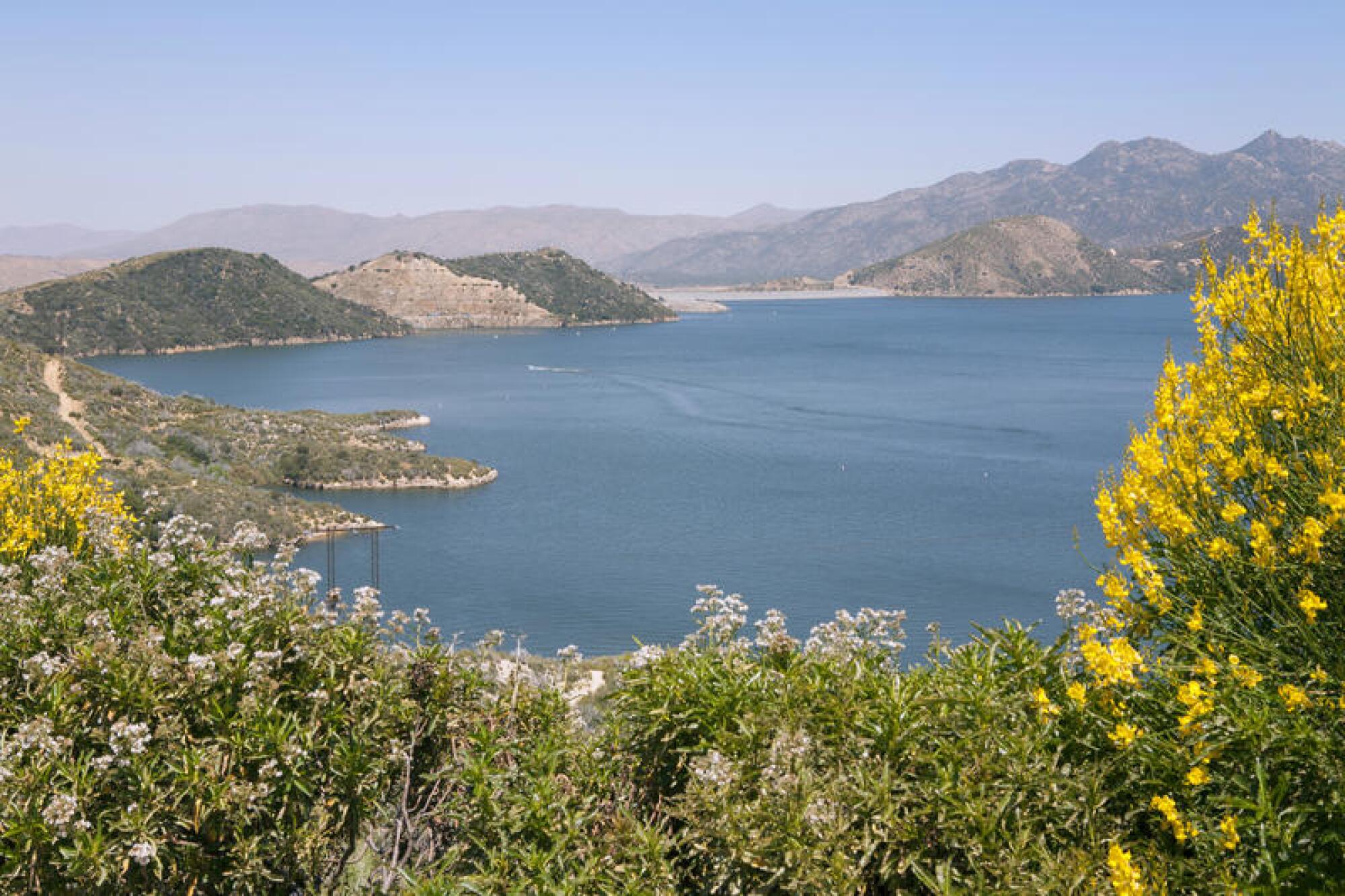
- Share via
California water officials are urging people and their pets to avoid Silverwood Lake in San Bernardino County after a toxic algal bloom was detected in the reservoir.
The Department of Water Resources has issued a caution advisory warning residents to avoid parts of the popular recreation spot until further notice due to the presence of harmful cyanobacteria, or blue-green algae, in the water.
Blue-green algae are a natural part of many ecosystems, but can grow, or “bloom,” rapidly under certain conditions including warmer water temperatures. Experts say the issue is getting worse as climate change, aging water infrastructure and human activities converge in water bodies across the state.
“These cyanobacteria blooms are very adaptable and have a lot of unique characteristics to help them excel and thrive and bloom compared to other species that are more beneficial and more benign,” said West Bishop, an algae scientist and research manager at the water quality restoration company Eutrophix, who has treated Silverwood Lake in the past. “They like it warmer.”
Bishop said rising global temperatures are part of the problem, as are higher carbon dioxide levels in the atmosphere and UV light penetration, which can spur the blooms. April marked the planet’s 11th consecutive month of record-breaking warm temperatures.
But blooms can also be promoted by the accumulation of nutrients such as phosphorus in reservoirs, lakes and surface waters, he said. Phosphorus is naturally occurring but can also come from agricultural runoff, leaky septic systems, stormwater drainage and other human activities.
“As these climate issues and concerns continue to be changed and altered, even things like dynamic weather patterns, periods of extreme drought, or really large rain events can flush more nutrients in,” Bishop said. “As our climate and our environment changes, all of these factors can promote those cyanobacteria harmful algal blooms. “
Exposure to harmful algal blooms can pose health risks including eye irritation, skin rashes, mouth ulcers, vomiting, diarrhea and cold- and flu-like symptoms, according to the Department of Water Resources. Pets are particularly vulnerable because they can ingest the water or lick it off their fur.
“This advisory is to protect the health and safety of park visitors and pets,” the DWR said in a statement about Silverwood Lake. “While swimming is allowed in the lake, visitors are advised to stay away from algae and scum in the water or on the shore. Do not let pets or other animals go into or drink the water or eat scum on the shore.”
With an average surface temperature of 59.05 degrees, the month was about 0.25 of a degree warmer than the previous hottest April, in 2016.
It’s not the first time the reservoir has been affected by the harmful blooms. The DWR has issued similar warnings there in recent months, including November 2022 and August 2023.
The age of a reservoir can also contribute to harmful algal blooms, as nutrients can build up or become entrenched in systems over time, Bishop said. Silverwood Lake, a part of the State Water Project, is over 50 years old.
“This is part of what’s called the eutrophication process, the aging of the lake or reservoir,” he said. “As conditions change, nutrient levels rise and you expect a resurgence of these blooms. It’s not an uncommon thing to have them, and they’re more likely to increase and get worse in the future too.”
It is also not the only waterway that has been impacted. The DWR’s harmful algal bloom database shows caution advisories are in effect at Lake Henshaw in San Diego County and Lake Elsinore in Riverside County, among others. Danger advisories are in effect at Lake Del Valle, Lake Chabot, Lago Los Osos and Lake Temescal in Alameda County.
General precautions include avoiding wading, swimming and jet- and water-skiing in water containing harmful algal blooms. Residents are also urged to avoid eating shellfish from affected water. Fish caught from the water should be cleaned well before cooking, and guts thrown away.
Though it is not always apparent when a bloom has become harmful, some signs to look for include small blue-green, white or brown particles in the water; streaks in the water that look like spilled paint; mats, scum or foam at the surface or along the shoreline; or an odor that smells septic, fishy or like gasoline. People should seek immediate medical treatment in case of exposure.
Bishop noted that there is a growing body of research showing cyanobacteria can produce many different types of toxins, including liver toxins, neurotoxins and gastrointestinal toxins. These toxins aren’t only potentially harmful to people and pets, but also any fish, birds or other wildlife associated with the water or local ecosystem.
“The more we’ve learned about their impacts to humans and animals and wildlife, the more we understand how devastating these toxins can be,” he said.
The DWR operates several reservoirs in California and regularly tests them for algal toxins, according to the agency. When toxins are found, testing continues along with posted health advisories until lab results show the harmful algal bloom is declining.
Silverwood Lake was treated with copper sulfate on Tuesday in an effort to control the algal bloom, agency officials said. However, the caution advisory will remain in place until the toxins are below the caution advisory level.
Drinking water quality will not be affected by the treatment, DWR said, adding that “copper sulfate is approved for use in water supply reservoirs.”
“The copper treatment will reduce the amount of these compounds and improve the water quality at downstream drinking water treatment plants,” the agency said.








